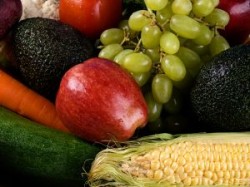Older people are most likely to improve their eating habits, but nutrition is important for people of all ages, says Walter Willet, M.D., chairman of the nutrition department at the Harvard School of Public Health. "We know that when people have health problems or their friends become ill, these are strong motivators of change," says Willet. "The more serious the health condition, the more serious the change. We'd rather people made changes early and prevent health problems in the first place."
So what if you're feeling trapped by a diet full of fast-food burgers and cookies? You can work your way out slowly but surely. Here are tips to move your eating habits in the right direction.
What are you eating now?
Write down what you eat for a few days to get a good picture of what you're taking in for healthier eating, suggests Cindy Moore, director of nutrition therapy at the Cleveland Clinic Foundation. "By looking at what you eat and how much you're eating, you can figure out what adjustments you need to make," she says.
Sometimes she asks patients to write down what they are feeling. Were you nervous, happy, or sad when you ate five slices of pizza in one sitting? "The very nature of writing things down in a food diary can help patients make changes," Moore says. "Someone will tell me, I didn't want to have to write that I ate nine cookies, so I ate two instead."
Make small changes to lose weight
[caption id="attachment_1503" align="alignleft" width="175"]
 Make small changes[/caption]
Make small changes[/caption]
You don't have to go cold turkey. In the end, you want to achieve a long-term healthy lifestyle. Small changes in healthier eating over time are the most likely to stick. If you want to eat more vegetables, then try to add one more serving by sneaking it in. Add bits of broccoli to something you already eat like pizza or soup. If you need more whole grains, add barley, whole wheat pasta, or brown rice to your soup."
Also, look for healthier versions of what you like to eat. If you like luncheon meat sandwiches, try a reduced-fat version. If you like the convenience of frozen dinners, look for ones with lower sodium. If you love fast-food meals, try a salad as your side dish instead of french fries.
When you think about what you need to get more of, the other things tend to fall into place, If you have some baby carrots with lunch or add a banana to your cereal in the morning, you're going to feel full longer. You won't need a food that's high in sugar or fat an hour later.
Lose weight with fruit for Healthier Eating
[caption id="attachment_9620" align="alignright" width="250"]
 Lose weight with Fruit[/caption]
Lose weight with Fruit[/caption]
The Dietary Guidelines recommend two cups of fruit per day at the 2,000-calorie reference diet. Fruit intake and recommended amounts of other food groups vary at different calorie levels. An example of two cups of fruit includes: one small banana, one large orange, and one-fourth cup of dried apricots or peaches.
Ways to incorporate fruit in your diet include adding it to your cereal, eating it as a snack with low-fat yogurt or a low-fat dip, or making a fruit smoothie for dessert by mixing low-fat milk with fresh or frozen fruit such as strawberries or peaches. Also, your family is more likely to eat fruit if you put it out on the kitchen table.
Eat a variety of fruits--whether fresh, frozen, canned, or dried--rather than fruit juice for most of your fruit choices. "The whole fruit has more fiber, it's more filling, and it's naturally sweet," says Marilyn Tanner, a pediatric dietitian at the Washington University School of Medicine in St. Louis. Still, some juices, such as orange and prune, are a good source of potassium.
Lose weight with whole grains
Like fruits and vegetables, whole grains are a good source of vitamins, minerals, and fiber. The Dietary Guidelines recommend at least three ounces of whole grains per day. One slice of bread, one cup of breakfast cereal, or one-half cup of cooked rice or pasta are each equivalent to about one ounce. Tanner suggests baked whole-grain corn tortilla chips or whole-grain cereal with low-fat milk as good snacks.
In general, at least half the grains you consume should come from whole grains. For many, but not all, whole grain products, the words "whole" or "whole grain" will appear before the grain ingredient's name. The whole grain must be the first ingredient listed in the ingredients list on the food package. The following are some whole grains: whol
No comments:
Post a Comment